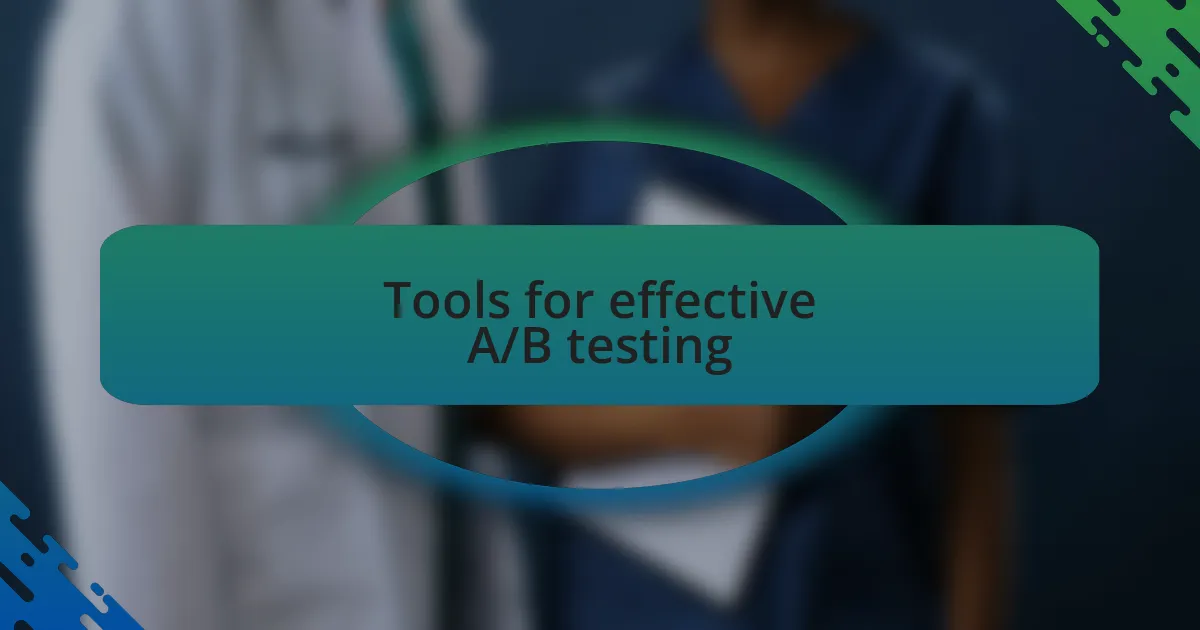Key takeaways:
- A/B testing is essential for making data-driven design decisions, replacing assumptions with real user interactions.
- Effective tools like Optimizely, Google Optimize, and Hotjar enhance A/B testing by offering robust data tracking and visualization.
- Patience is crucial in A/B testing; meaningful insights often take time to develop.
- Statistical significance is vital for reliable test conclusions; not all results signify success.

Understanding A/B testing concepts
A/B testing, at its core, is about comparison—two versions of a web page or app feature are pitted against each other to determine which performs better. I remember the first time I conducted an A/B test for a client’s landing page; it was thrilling to see real-time data revealing what users actually preferred. This moment underscored for me how critical it is to rely on tangible evidence rather than gut feelings in design decisions.
When I analyze user behavior, I often ask myself why a particular version resonates more than another. Is it the color scheme, the positioning of buttons, or the wording of a call-to-action? This intrinsic curiosity is what makes A/B testing so invaluable. Each test offers insight and helps refine user experience based on real user interactions rather than assumptions.
Have you ever felt unsure about a design choice? That’s where A/B testing shines. It empowers you to validate your ideas with concrete results—transforming uncertainty into data-driven confidence. Through this process, I’ve learned that what looks good on paper doesn’t always translate into user engagement, and that revelation can change your entire approach to design.

Tools for effective A/B testing
When it comes to tools for effective A/B testing, I’ve found that using platforms like Optimizely or Google Optimize can simplify the process tremendously. With user-friendly interfaces and robust tracking capabilities, they provide not just data, but also context for those numbers. I still remember my first experience with Google Optimize; I was amazed at how easy it was to set up a test and immediately start gathering information on user interactions.
Another tool worth mentioning is Hotjar, which pairs excellent heatmaps with A/B testing features. This combination allows you to visualize where users click and how far they scroll, adding a layer of understanding beyond just conversion rates. I recall using Hotjar during a test on a pricing page, and the heatmap unveiled insights I hadn’t anticipated, steering my redesign in a more user-centric direction.
Finally, don’t underestimate the power of simpler tools like spreadsheets for analysis. While they may lack the automation of more advanced platforms, I’ve often used them to track results manually when testing specific elements. This hands-on approach gives me a clearer picture of the changes that make a difference, prompting me to consider, how well do I really know my audience’s preferences? By organizing data visually, I’ve been able to discover patterns that even the most sophisticated tools might miss.

Lessons learned during A/B testing
One key lesson I’ve learned from A/B testing is the importance of patience. Initially, I rushed through testing, eager to see quick results, only to realize that meaningful insights take time. It’s like waiting for a fine wine to mature; sometimes, the best findings come after letting the data sit and develop.
Another crucial takeaway is the significance of statistical significance in determining the outcome of a test. I recall an instance where I celebrated a change in conversion rates, only to discover later that the sample size was too small to make a reliable conclusion. It’s a sobering reminder that not every increase is a win; sometimes, it’s just noise in the data.
Lastly, I’ve come to appreciate that not all tests will have clear winners. I once conducted an A/B test on email subject lines, and while one variation performed slightly better, both garnered engagement. This experience taught me that sometimes the real takeaway is understanding the audience’s varied preferences rather than chasing a singular optimal solution. How do you gauge success when the results are ambiguous? Embracing uncertainty has become part of my testing philosophy.